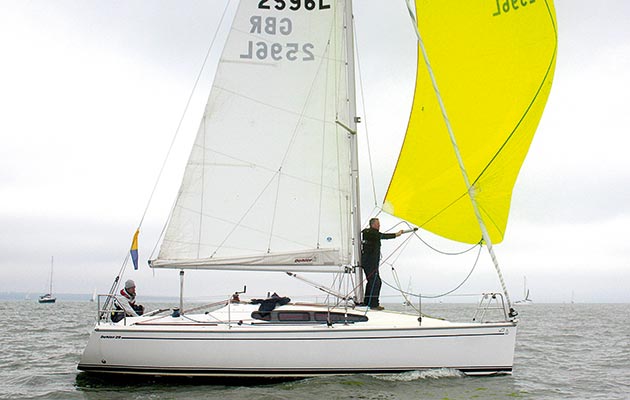Practice makes perfect when it comes to this most difficult short-handed sailing manoeuvre, says Pip Hare.
Gybing a symmetric kite double-handed is a tough manoeuvre and there is no question that practice makes perfect. Setting up your boat so things are within reach is essential, as you may need to reach sheets and guys from the steering position and the pole uphaul from the bow.
Other than in very light winds or with small spinnakers, gybing with sheets and guys is a must – if you choose single sheets, make sure you have the strength to push the guy out in all conditions.
Preparation
Before going into the gybe think about where you want your kite to fly: allowing it to fly up might help to keep the sail full, but will make it less stable, whereas using the tweakers to pull it down too much could mean it is prone to collapse. As a rule of thumb I normally set the tweakers to guardrail height.
For end to end gybing I will go into the gybe deep, with the pole squared back, rotating the spinnaker well onto the windward side of the boat. Set the pilot to drive dead downwind with the mainsail well out. Put the windward sheet onto a winch and wind it in until visibly taking the weight of the windward clew.
Gybe the boat on the autopilot, through a shallow angle – around 20° should suffice if you were deep to start with – swinging the main over as you do so. With the main on the new side release the old guy and head up another 10° or 20° to ensure the spinnaker is blowing to leeward.
How to set up your autopilot to sail faster, more comfortably and be more efficient
At this stage the crew in the cockpit should be trimming the spinnaker while the other heads to the foredeck and gybes the pole. Keeping the spinnaker on the leeward side of the boat should avoid wraps until the new pole is on.

Square back the pole and sail deep downwind before heading into the gybe.
Dip pole gybe
Dip-pole gybing is more complicated for a crew of two so I choose to hand steer through this one, while my co-skipper does everything else. Set the spinnaker to fly in the centre of the boat, square the pole back, but keep the leeward sheet on, so the spinnaker does not over-rotate. You can sheet the main in at this point if you want.
The helmsman should now steer to keep the spinnaker full at all costs, allowing the boat to gybe when it feels natural. The other crew secures both sheets – ensuring the windward one has the weight of the sail – releases the guy and then heads forward to gybe the pole.
If you have a dip-pole then spend some time on the dock ensuring you have a good one-man set-up: the pole uphaul must be mast- and even foredeck-operable, poles must trip from both ends and mast cleats must be in the right place. It is easy to get a wrap around the pole end once the new guy is in, if it’s not pulled through as the pole is hoisted.
This could be a job for the helmsman if it’s within their reach, but beware as getting distracted from steering before the pole is set can easily lead to wraps. If not, the foredeck crew can pull a handful of the guy through the pole from the foredeck, then come back and tail the rest from the cockpit.

A dip pole gybe is more complicated short-handed, but can be done if the crew goes forward.
Quick tips for gybing a symmetric spinnaker short-handed
Practise pole-less sailing with the spinnaker as much as possible – if you are confident you can keep the sail full you will have all the time in the world to complete the gybe.
Make sure split backstays or runners are free to run out on the windward side to avoid getting the main pinned in and rounding up.
Set the traveller to windward before the gybe.
If you get a wrap give yourself a short time limit to sort it out (I’d say less than one minute) if it can’t be sorted then take it down and rehoist.
Attaching a long line to the middle of the pole will allow you to swing it into the boat while dropping the uphaul at the mast.
End to end gybes are slightly easier for two people as the pole can be managed from the mast




